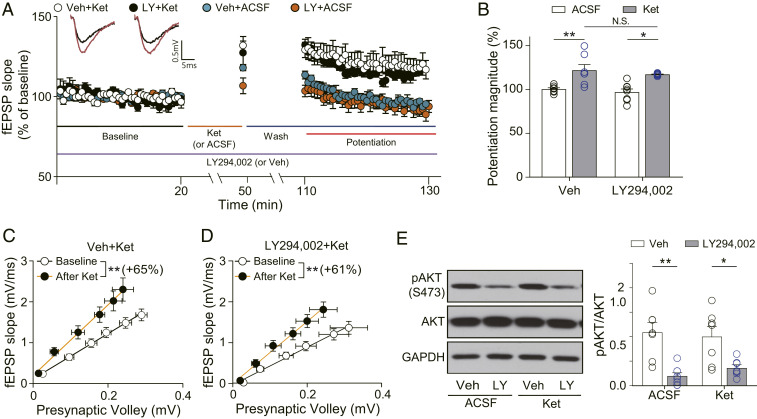Fig. 4.
PI3K inhibition does not affect ketamine potentiation. (A) Ketamine potentiation was measured after 20 min of baseline measurement, 30 min of ketamine perfusion, and 1 h of washout period in the hippocampal CA1 region. LY294002 was applied for the whole duration of the experiment. All responses were normalized to respective baselines. (Inset) Representative waveforms during baseline (black) or ketamine potentiation (red) measurement. (B) A bar graph that summarizes the magnitudes of ketamine potentiation of respective groups measured in A. LY294002 did not affect synaptic potentiation induced by ketamine [two-way ANOVA with Tukey’s multiple comparisons, LY294002 × ketamine: F(1, 25) = 0.3351, P = 0.5678, LY294002: F(1, 25) = 0.661, P = 0.4239, ketamine: F(1, 25) = 27.23, P < 0.0001, n = 7 to 8 per group]. (C and D) I–O curves measured during baseline and potentiation measurement in A. Initial slopes of fEPSPs versus presynaptic volley values are plotted at 4, 8, 12, 16, 20, and 24 μA stimulation intensity. The slope of the I–O curve was significantly increased after ketamine treatment in both the vehicle-treated and the LY294002-treated slices with similar increase rates [Paired t test, DMSO+Ket (C): t(6) = 3.737, P = 0.0097, n = 7; LY294002+Ket (D): t(6) = 4.528, P = 0.0040, n = 7]. (E) Western blots and quantification of AKT and pAKT. Samples were collected after completion of the recording in A. AKT phosphorylation was significantly decreased by LY294002 treatment regardless of ketamine treatment, confirming the pharmacological effects of LY294002 [two-way ANOVA with Tukey’s multiple comparisons, LY294002 × ketamine: F(1, 25) = 0.7331, P = 0.4000, LY294002: F(1, 25) = 26.89, P < 0.0001, ketamine: F(1, 25) = 0.0690, P = 0.795, n = 7 to 8 per group]. All data represented as mean ± SEM; *P < 0.05 and **P < 0.01.

